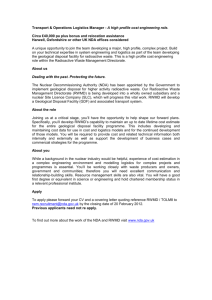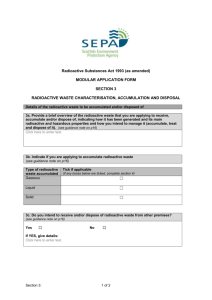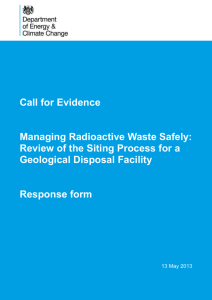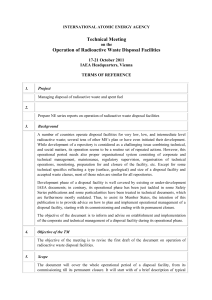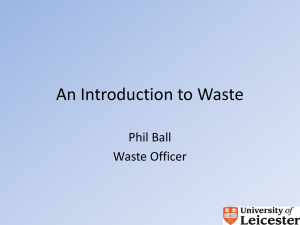MRWS Call for Evidence
advertisement
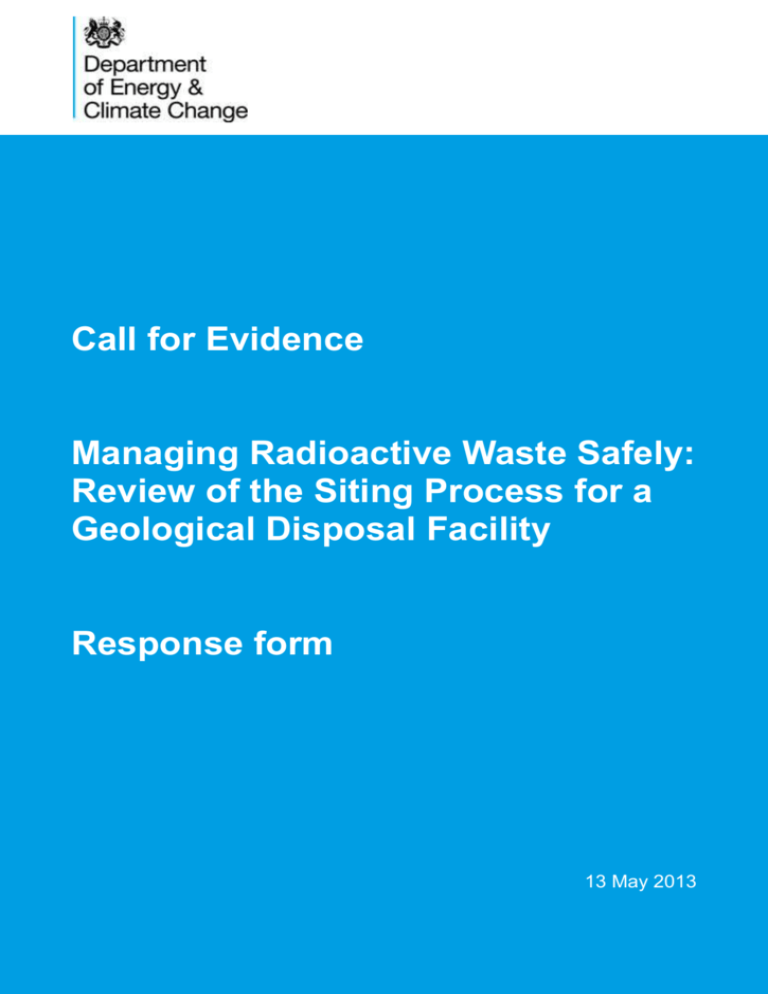
Call for Evidence Managing Radioactive Waste Safely: Review of the Siting Process for a Geological Disposal Facility Response form 13 May 2013 Call for Evidence - Managing Radioactive Waste Safely: Review of the Siting Process for a Geological Disposal Facility Call for Evidence Please use this form to answer questions on the Call for Evidence on Managing Radioactive Waste Safely: Review of the Siting Process for a Geological Disposal Facility. The closing date for the submission of responses is 10 June 2013. Responses can be returned by email (preferable) or post. Email address: radioactivewaste@decc.gsi.gov.uk Or by post to: The Managing Radioactive Waste Safely team Department of Energy and Climate Change 55 Whitehall London SW1A 2EY In order to help us analyse responses, please provide details of your organisation. When the call for evidence ends, we may publish or make public the evidence submitted. Also, members of the public may ask for a copy of responses under freedom of information legislation. If you do not want your response - including your name, contact details and any other personal information – to be publicly available, please say so clearly in writing when you send your response to the call for evidence. Please note, if your computer automatically includes a confidentiality disclaimer, that will not count as a confidentiality request. Please explain why you need to keep details confidential. We will take your reasons into account if someone asks for this information under freedom of information legislation. But, because of the law, we cannot promise that we will always be able to keep those details confidential. The responses to this Call for Evidence will inform a public consultation that will follow in the autumn. We would like to keep stakeholders who are interested in the MRWS process up to date on developments. If you would like to be kept up to date please sign up at the end of the form. 2 Call for Evidence - Managing Radioactive Waste Safely: Review of the Siting Process for a Geological Disposal Facility Introduction 1. The UK Government’s policy for the long-term management of higher-activity radioactive waste is geological disposal1. In 2008 the Managing Radioactive Waste Safely (MRWS) White Paper2 was published which outlined a framework for implementing geological disposal based on the principles of voluntarism and partnership. 2. Three local authorities formally expressed an interest in the MRWS programme: Copeland and Allerdale Borough Councils, and Cumbria County Council. In January 2013, the three local authorities voted on whether to proceed to stage 4 of the process. The two boroughs voted in favour, but the county voted against. The Government had in 2011 given a specific undertaking that the existing site-selection process would only continue in west Cumbria if there was agreement at both borough and county level. The county’s decision therefore ended the existing site selection process in west Cumbria. 3. Shepway District Council in Kent had also taken soundings from local residents, but subsequently decided against making a formal expression of interest in the current MRWS process. 4. The Government remains firmly committed to geological disposal as the right policy for the long-term safe and secure management of higher-activity radioactive waste. The Government also continues to hold the view that the best means of selecting a site for a geological disposal facility (GDF) is an approach based on voluntarism and partnership. 5. Evidence from abroad shows that this approach can work, with similar waste disposal programmes based on these key principles making good progress in countries like Canada, Finland, France and Sweden. 6. The fact that two local authorities in west Cumbria voted in favour of continuing the search for a potential site for a GDF demonstrates that communities recognise the substantial benefits that are associated with hosting such a facility – both in terms of job creation and the wider benefits associated with its development. Purpose of the call for evidence 7. In line with the Secretary of State’s written Ministerial statement of 31 January 20133, Government has been considering what lessons can be learned from the experiences of 1 Radioactive waste disposal is a devolved matter. The Scottish Government has a separate policy and supports long-term interim storage and an on-going programme of research and development. The Welsh Government has reserved its position on geological disposal of radioactive waste while continuing to play an active part in the MRWS process. The Department of the Environment in Northern Ireland supports the MRWS programme. 2 Managing Radioactive Waste Safely: A Framework for Implementing Geological Disposal https://www.gov.uk/government/publications/managing-radioactive-waste-safely-a-framework-for-implementinggeological-disposal 3 See https://www.gov.uk/government/speeches/written-ministerial-statement-by-edward-davey-on-themanagement-of-radioactive-waste 3 Call for Evidence - Managing Radioactive Waste Safely: Review of the Siting Process for a Geological Disposal Facility the MRWS programme in west Cumbria and elsewhere. We are now inviting views on the site selection aspects of the ongoing MRWS programme in this call for evidence, particularly from those who have been engaged in (or have been interested observers of) the MRWS process to date. The responses to this call for evidence will inform a consultation that will follow later in the year. Background 8. Higher-activity radioactive wastes are produced as a result of the generation of electricity in nuclear power stations, from the associated production and processing of the nuclear fuel, from the use of radioactive materials in industry, medicine and research, and from military nuclear programmes. 9. As one of the pioneers of nuclear technology, the UK has accumulated a substantial legacy of higher activity radioactive materials. Some of it has already been processed and placed in safe and secure interim storage on nuclear sites. However, most will only become waste over the next century or so as existing facilities reach the end of their lifetime and are decommissioned and cleaned up safely and securely. 10. These higher-activity wastes can remain radioactive, and thus potentially harmful, for hundreds of thousands of years. Modern, safe and secure interim storage can contain all this material – but this method of storage requires on-going human intervention to monitor the material and to ensure that it does not pose any risk to human or environmental health. While the Government believes that safe and secure interim storage is an effective method of managing waste in the short to medium term, the Government is committed to delivering a permanent disposal solution. 11. In October 2006, following recommendations made by the independent Committee on Radioactive Waste Management, the Government announced its policy of geological disposal, preceded by safe and secure interim storage. The Government subsequently announced that it would pursue a policy of geological disposal with site selection on voluntarism and partnership. This remains Government policy. Geological disposal 12. Geological disposal involves isolating radioactive waste in an engineered facility deep inside a suitable rock formation to ensure that no harmful quantities of radioactivity ever reach the surface environment. It is a multi-barrier approach, based on placing packaged wastes in engineered tunnels at a depth of between 200 and 1000m underground, protected from disruption by man-made or natural events. 13. Geological disposal is internationally recognised as the preferred approach for the longterm management of higher-activity radioactive waste. It provides a long-term, safe solution to radioactive waste management that does not depend on on-going human intervention. 4 Call for Evidence - Managing Radioactive Waste Safely: Review of the Siting Process for a Geological Disposal Facility Response form Please use this form to respond to this call for evidence on Managing Radioactive Waste Safely: Review of the Siting Process for a Geological Disposal Facility. The closing date for the submission of responses is 10 June 2013. Responses can be returned by email (preferable) or post. Email address: radioactivewaste@decc.gsi.gov.uk Or by post to: The Managing Radioactive Waste Safely team Department of Energy and Climate Change Room M07 55 Whitehall London SW1A 2EY Name Organisation / Company Organisation Size (no. of employees) Organisation Type Job Title Department Address Email Telephone Fax Would you like to be kept informed of developments with the MRWS programme? Yes/No Would you like your response to be kept confidential? If yes please give a reason Yes/No 5 Call for Evidence - Managing Radioactive Waste Safely: Review of the Siting Process for a Geological Disposal Facility The Government is interested in your views on the geological disposal facility site selection process outlined in the 2008 Managing Radioactive Waste Safely (MRWS) White Paper. To assist us you may wish to consider the following issues in your response: 6 What aspects of the site selection process in the MRWS White Paper do you think could be improved and how? What do you think could be done to attract communities into the MRWS site selection process? What information do you think would help communities engage with the MRWS site selection process? Call for Evidence - Managing Radioactive Waste Safely: Review of the Siting Process for a Geological Disposal Facility 7 © Crown copyright 2013 Department of Energy & Climate Change 3 Whitehall Place London SW1A 2AW www.gov.uk/decc URN 13D/105
